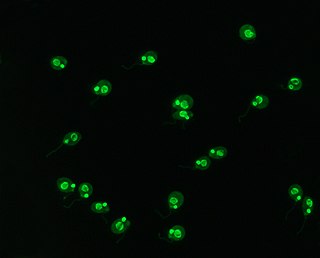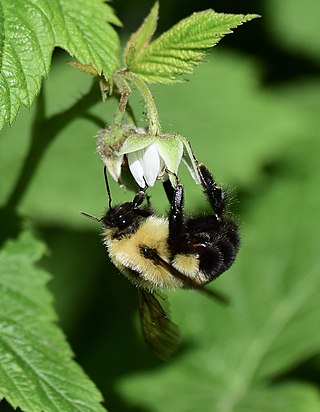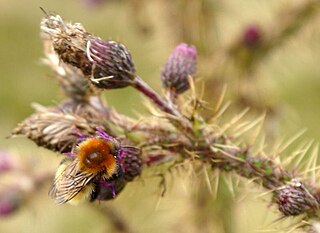Related Research Articles

A bumblebee is any of over 250 species in the genus Bombus, part of Apidae, one of the bee families. This genus is the only extant group in the tribe Bombini, though a few extinct related genera are known from fossils. They are found primarily in higher altitudes or latitudes in the Northern Hemisphere, although they are also found in South America, where a few lowland tropical species have been identified. European bumblebees have also been introduced to New Zealand and Tasmania. Female bumblebees can sting repeatedly, but generally ignore humans and other animals.

Crithidia is a genus of trypanosomatid Euglenozoa. They are parasites that exclusively parasitise arthropods, mainly insects. They pass from host to host as cysts in infective faeces and typically, the parasites develop in the digestive tracts of insects and interact with the intestinal epithelium using their flagellum. They display very low host-specificity and a single parasite can infect a large range of invertebrate hosts. At different points in its life-cycle, it passes through amastigote, promastigote, and epimastigote phases; the last is particularly characteristic, and similar stages in other trypanosomes are often called crithidial.

Bombus terrestris, the buff-tailed bumblebee or large earth bumblebee, is one of the most numerous bumblebee species in Europe. It is one of the main species used in greenhouse pollination, and so can be found in many countries and areas where it is not native, such as Tasmania. Moreover, it is a eusocial insect with an overlap of generations, a division of labour, and cooperative brood care. The queen is monogamous which means she mates with only one male. B. terrestris workers learn flower colours and forage efficiently.

Deformed wing virus (DWV) is an RNA virus, one of 22 known viruses affecting honey bees. While most commonly infecting the honey bee, Apis mellifera, it has also been documented in other bee species, like Bombus terrestris, thus, indicating it may have a wider host specificity than previously anticipated. The virus was first isolated from a sample of symptomatic honeybees from Japan in the early 1980s and is currently distributed worldwide. It is found also in pollen baskets and commercially reared bumblebees. Its main vector in A. mellifera is the Varroa mite. It is named after what is usually the most obvious deformity it induces in the development of a honeybee pupa, which is shrunken and deformed wings, but other developmental deformities are often present.

Bombus hortorum, the garden bumblebee or small garden bumblebee, is a species of bumblebee found in most of Europe north to 70°N, as well as parts of Asia and New Zealand. It is distinguished from most other bumblebees by its long tongue used for feeding on pollen in deep-flowered plants. Accordingly, this bumblebee mainly visits flowers with deep corollae, such as deadnettles, ground ivy, vetches, clovers, comfrey, foxglove, and thistles. They have a good visual memory, which aids them in navigating the territory close to their habitat and seeking out food sources.

Bombus lucorum, the white-tailed bumblebee, is a species of bumblebee, widespread and common throughout Europe. This name has been widely used for a range of nearly identical-looking or cryptic species of bumblebees. In 1983, Scholl and Obrecht even coined the term Bombus lucorum complex to explain the three taxa that cannot be easily differentiated from one another by their appearances. A recent review of all of these species worldwide has helped to clarify its distribution in Europe and northern Asia, almost to the Pacific. B. lucorum reaches the Barents Sea in the North. However, in southern Europe, although found in Greece it is an upland species with its distribution never quite reaching the Mediterranean.

The two-spotted bumble bee is a species of social bumble bee found in the eastern half of the United States and the adjacent south-eastern part of Canada. In older literature this bee is often referred to as Bremus bimaculatus, Bremus being a synonym for Bombus. The bee's common name comes from the two yellow spots on its abdomen. Unlike many of the other species of bee in the genus Bombus,B. bimaculatus is not on the decline, but instead is very stable. They are abundant pollinators that forage at a variety of plants.

Bombus vosnesenskii, the yellow-faced bumblebee, is a species of bumblebee native to the west coast of North America, where it is distributed from British Columbia to Baja California. It is the most abundant species of bee in this range, and can be found in both urban and agricultural areas. Additionally, B. vosnesenskii is utilized as an important pollinator in commercial agriculture, especially for greenhouse tomatoes. Though the species is not currently experiencing population decline, urbanization has affected its nesting densities, and early emergence of the B. vosnesenskii has been implicated in the increasing lack of bee diversity on the West coast.

Sphaerularia bombi is an entomopathogenic nematode. It is parasite of bumblebees. It infects and sterilizes gynes or potential queens of bumblebees.
Nosema bombi is a microsporidian, a small, unicellular parasite recently reclassified as a fungus that mainly affects bumble bees. It was reclassified as Vairimorpha bombi in 2020. The parasite infects numerous Bombus spp. at variable rates, and has been found to have a range of deleterious effects on its hosts.

Bombus ruderatus, the large garden bumblebee or ruderal bumblebee, is a species of long-tongued bumblebee found in Europe and in some parts of northern Africa. This species is the largest bumblebee in Britain and it uses its long face and tongue to pollinate hard-to-reach tubed flowers. Bumblebees are key pollinators in many agricultural ecosystems, which has led to B. ruderatus and other bumblebees being commercially bred and introduced into non-native countries, specifically New Zealand and Chile. Since its introduction in Chile, B. ruderatus has spread into Argentina as well. Population numbers have been declining and it has been placed on the Biodiversity Action Plan to help counteract these declines.

Bombus muscorum, commonly known as the large carder bee or moss carder bee, is a species of bumblebee in the family Apidae. The species is found throughout Eurasia in fragmented populations, but is most commonly found in the British Isles. B. muscorum is a eusocial insect. The queen is monandrous, mating with only one male after leaving a mature nest to found its own. Males mate territorially and the species is susceptible to inbreeding and bottlenecks. The species builds its nests on or just under the ground in open grassland and forages very close to the nest. In recent years, populations have significantly declined due to loss of natural habitat. B. muscorum is currently listed as vulnerable in Europe by the European Red List of Bees.

Bombus dahlbomii, also known as the moscardón, is a species of bumblebee endemic to southern South American temperate forests. B. dahlbomii is one of the largest bee species in the world, with matured queens growing up to 40 mm (1.6 in) long. Because of its size and furry appearance, the species has been described as "flying mice" colloquially, and "a monstrous fluffy ginger beast" by British ecologist David Goulson.

Bombus affinis, commonly known as the rusty patched bumble bee, is a species of bumblebee endemic to North America. Its historical range in North America has been throughout the east and upper Midwest of the United States, north to Ontario, Canada, where it is considered a "species at risk", east to Quebec, south to Georgia, and west to the Dakotas. Its numbers have declined in 87% of its historical habitat range. On January 10, 2017, the United States Fish and Wildlife Service placed B. affinis on the list of endangered species, making the rusty patched bumblebee the first bee to be added to the list in the continental United States.
Spillover infection, also known as pathogen spillover and spillover event, occurs when a reservoir population with a high pathogen prevalence comes into contact with a novel host population. The pathogen is transmitted from the reservoir population and may or may not be transmitted within the host population. Due to climate change and land use expansion, the risk of viral spillover is predicted to significantly increase.

Bombus terricola, the yellow-banded bumblebee, is a species of bee in the genus Bombus. It is native to southern Canada and the east and midwest of the United States. It possesses complex behavioral traits, such as the ability to adapt to a queenless nest, choose which flower to visit, and regulate its temperature to fly during cold weather. It was at one time a common species, but has declined in numbers since the late 1990s, likely due to urban development and parasite infection. It is a good pollinator of wild flowers and crops such as alfalfa, potatoes, raspberries, and cranberries.

The half-black bumblebee is a small bumblebee with a wide distribution in North America, its range extending from Ontario to Nova Scotia and southward to Georgia.
Apicystis is a genus of parasitic alveolates of the phylum Apicomplexa.
Bombus hypocrita, also known as the short-tongued bumblebee, is a Japanese bumblebee commonly used in commercial pollination. These short-tongued bumblebees have a proboscis about 7-9mm long, which is folded under their head when flying. Bumblebees are a small fuzzy insect with yellow and black banding along their abdomen. They are round and covered in pile, the hair-like structures that give them their distinct fuzzy appearance.
Crithidia bombi is a parasitic protist from the order Trypanosomatida. It is the most prevalent parasite of bumblebees.
References
- ↑ Liu HJ, Macfarlane RP, Pengelly DH (1974). "Mattesia bombi n. sp. (Neogregarinida: Ophrocystidae), a parasite of Bombus (Hymenoptera: Apidae)". Journal of Invertebrate Pathology. 23 (2): 225–231. Bibcode:1974JInvP..23..225L. doi:10.1016/0022-2011(74)90188-8. PMID 4207630.
- 1 2 3 4 Lipa, J.J.; Triggiani, O. (1996). "Apicystis gen nov and Apicystis bombi (Liu, Macfarlane & Pengelly) comb nov (Protozoa: Neogregarinida), a cosmopolitan parasite of Bombus and Apis (Hymenoptera: Apidae)". Apidologie. 27 (1): 29–34. doi: 10.1051/apido:19960104 .
- 1 2 Plischuk, S.; Meeus, I.; Smagghe, G.; Lange, C.E. (2011). "Apicystis bombi (Apicomplexa: Neogregarinorida) parasitizing Apis mellifera and Bombus terrestris (Hymenoptera: Apidae) in Argentina". Environmental Microbiology Reports. 3 (5): 565–568. Bibcode:2011EnvMR...3..565P. doi:10.1111/j.1758-2229.2011.00261.x. PMID 23761336.
- 1 2 Evans, Jay D.; Schwarz, Ryan S. (2011). "Bees brought to their knees: microbes affecting honey bee health". Trends in Microbiology . 19 (12). Cell Press: 614–620. doi:10.1016/j.tim.2011.09.003. ISSN 0966-842X. PMID 22032828.
- ↑ Plischuk, S.; Lange, C.E. (2009). "Invasive Bombus terrestris (Hymenoptera: Apidae) parasitized by a flagellate (Euglenozoa: Kinetoplastea) and a neogregarine (Apicomplexa: Neogregarinorida)". Journal of Invertebrate Pathology. 102 (3): 263–265. Bibcode:2009JInvP.102..263P. doi:10.1016/j.jip.2009.08.005. PMID 19682459.
- ↑ Goulson, Dave (2013). "Argentinian invasion!". Buzzword. 21: 17–18.
- 1 2 King, Anthony (2012-09-14). "Plight of the Bumblebee". ScienceNow. Retrieved 2015-02-16.
- ↑ Rutrecht, T; Brown, J (2008). "The life-history impact and implications of multiple parasites for bumble bee queens". International Journal for Parasitology. 38 (1): 799–808. doi:10.1016/j.ijpara.2007.11.004. PMID 18164709.
- ↑ Lipa, J.J; Triggiani, O (1996). "Apicystis gen nov and Apicystis bombi (Liu, Macfarlane & Pengelly) comb nov (Protozoa: Neogregarinida), a cosmopolitan parasite of Bombus and Apis (Hymenoptera: Apidae)". Apidologie. 27 (1): 29–34. doi: 10.1051/apido:19960104 . Retrieved 15 October 2015.
- 1 2 "Newsletter of the BumbleBee Specialist Group" (PDF). Bumblebee Conservator. 2014.
- ↑ Graystock, Peter; Yates, Kathryn; Evison, Sophie E. F.; Darvill, Ben; Goulson, Dave; Hughes, William O. H. (2013). "The Trojan hives: pollinator pathogens, imported and distributed in bumblebee colonies". Journal of Applied Ecology. 50 (5): 1207–1215. Bibcode:2013JApEc..50.1207G. doi:10.1111/1365-2664.12134. S2CID 3937352.
- ↑ Graystock, Peter; Goulson, Dave; Hughes, William O.H. (12 August 2014). "The relationship between managed bees and the prevalence of parasites in bumblebees". PeerJ. 2: e522. doi: 10.7717/peerj.522 . PMC 4137657 . PMID 25165632.
- 1 2 Graystock, P.; Meeus, I.; Smagghe, G.; Goulson, D.; Hughes, W. O. H. (9 December 2015). "The effects of single and mixed infections of Apicystis bombi and deformed wing virus in Bombus terrestris". Parasitology. 143 (3): 358–365. doi:10.1017/S0031182015001614. PMID 26646676. S2CID 44770028.
- ↑ Jones, C. M.; Brown, M. J. F.; Ings, T. (November 2014). "Parasites and genetic diversity in an invasive bumblebee". Journal of Animal Ecology. 83 (6): 1428–1440. Bibcode:2014JAnEc..83.1428J. doi:10.1111/1365-2656.12235. PMC 4235342 . PMID 24749545.